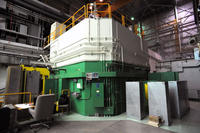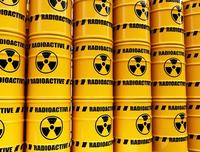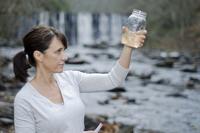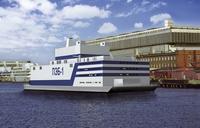-
DOE to resume transient testing of nuclear fuels and materials

Transient testing of nuclear fuel involves placing fuel or material into the core of a nuclear reactor and subjecting it to short bursts of intense, high-power radiation in order to analyze the effects of the radiation. The Idaho National Laboratory (INL) Transient Reactor Test Facility began operating on 23 February 1959 and was a principal reactor safety testing facility in the United States for thirty-five years. The U.S. Department of Energy invites the public to read and comment on a draft environmental assessment it has prepared for a proposal to resume transient testing of nuclear fuels and materials.
-
-
Sunlight-activated nanogrid breaks down pollutants in water
Oil spills do untold damage to the environment — to the waters they pollute and to marine and other wildlife. The Deepwater Horizon spill in the Gulf of Mexico in 2010, for example, the largest accidental marine oil spill in the history of the petroleum industry, flowed unabated for three months. Typically, such oil spills are extraordinarily difficult to clean up. Soon, however, the process may become infinitely easier and ecologically friendly, the result of a new invention — “nanogrid” — a large net consisting of metal grids made of a copper tungsten oxide, that, when activated by sunlight, can break down oil from a spill, leaving only biodegradable compounds behind.
-
-
Nuclear experts: world is safer, but risks remain
Speaking at a two-day short course on Nuclear Weapon Issues in the Twenty-First Century earlier this month, leading nuclear weapons scientists and policymakers said that despite some troubling areas, the world is a safer place than in past decades, and they expressed cautious optimism it is continuing in that direction. They warned, however, that despite this progress, crises involving nuclear weapons can still spiral out of control.
-
-
Reducing volume of nuclear waste by 90 percent possible

Engineers have developed a way significantly to reduce the volume of some higher activity wastes, which will reduce the cost of interim storage and final disposal. The researchers have shown that mixing plutonium-contaminated waste with blast furnace slag and turning it into glass reduces its volume by 85-95 percent. It also effectively locks in the radioactive plutonium, creating a stable end product.
-
-
The irreducible elements of a Freeze Plus interim agreement with Iran
Iran and the P5+1 are set to resume talks on Iran’s nuclear program tomorrow, Thursday, 7 November in Geneva.The Institute for Science and International Security (ISIS) has developed a list of what it calls “irreducible elements” which a negotiated interim agreement should aim to achieve. These four elements are: Stopping the advance of Iran’s centrifuge and Arak reactor programs; extending breakout times; capping the Iranian centrifuge program and ensuring that it will not expand beyond this cap (in terms of enrichment output) during the next 5-15 years; and increasing the chance of finding a secret centrifuge or plutonium separation plant.
-
-
China buys Implant Sciences explosives detectors to protect nuclear power plants
Implant Sciences has sold multiple units of its QS-H150 handheld explosives trace detectors to a customer in China, who will be deploy them across several locations for the purpose of protecting nuclear power plants in multi-layered security environments.
-
-
Pyreos, ultra‐low power consumption IR sensor specialist, secures $4 million investment
Edinburgh, Scotland-based Pyreos Limited, a specialist in ultra‐low power consumption infrared sensor technology, the other day announced plans for international expansion after securing a further funding round of $4 million. It is possible to use Pyreos sensor arrays in many applications, among them border security, where they can identify human movement at distances of several kilometers.
-
-
Detecting threats in a crowd
Around a military camp situated close to a built-up area there are always people moving about. Scientists at FOI, the Swedish Defense Research Agency, have created a multi-sensor system designed to be able to detect threats by identifying unusual patterns of movement involving individuals or groups.
-
-
Quick ID for water pathogens

New research purports to help people stay healthy by developing a real-time water bug testing that could precisely identify the culprits responsible for waterborne disease.
-
-
Where should U.S. radioactive waste be buried?
In the United States, about 70,000 metric tons of spent commercial nuclear fuel are located at more than seventy sites in thirty-five states. Shales and other clay-rich (argillaceous) rocks have never been seriously considered for holding America’s spent nuclear fuel, but it is different overseas. France, Switzerland, and Belgium are planning to put waste in tunnels mined out of shale formations, and Canada, Japan, and the United Kingdom are evaluating the idea.
-
-
Russia to build floating nuclear power plants

Global warming is opening the Arctic Ocean to shipping – and causing the rapid melting of Arctic ice. Russia says that ship-based nuclear power plants would allow it to provide power to remote cities in Siberia, and provide power to oil and gas drilling operations in the Arctic (about 30 percent of the world’s unclaimed natural gas is in the Arctic, and about, 60 percent of that unclaimed natural gas is in the Russian Arctic). Experts worry about the ability of ship-based nuclear reactor to withstand extreme weather events, or terrorist attacks. The U.S. Army deployed its own floating nuclear reactor – the Sturgis – in the Panama Canal Zone from 1968 to 1976.
-
-
Where should U.S. radioactive waste be buried?
In the United States, about 70,000 metric tons of spent commercial nuclear fuel are located at more than seventy sites in thirty-five states. Shales and other clay-rich (argillaceous) rocks have never been seriously considered for holding America’s spent nuclear fuel, but it is different overseas. France, Switzerland, and Belgium are planning to put waste in tunnels mined out of shale formations, and Canada, Japan, and the United Kingdom are evaluating the idea.
-
-
Video imaging system for remote detection of hidden threats
By adapting superconducting technology used in advanced telescope cameras, researchers have built a prototype video imaging system for detecting hidden weapons and other threats at distances up to twenty-eight meters away.
-
-
Nuclear fuel withstands accident conditions’ high-temperature

A safer and more efficient nuclear fuel is on the horizon. A team of researchers have reached a new milestone with tristructural-isotropic (TRISO) fuel, showing that this fourth-generation reactor fuel might be even more robust than previously thought. Byproducts of the fission process have the potential to escape the fuel, especially at very high temperatures. Controlled, high-temperature testing of irradiated TRISO) fuel demonstrated that fission product release remains relatively low at high temperatures postulated to occur in accidents and beyond.
-
-
Sharp increase in radioactive water leaks at Fukushima
Tokyo Electric Power(TEPCO) has reported a rise in groundwater radiation levels, saying a tank at the firm’s Fukushima plant leaked 300 metric tons of toxic water in August 2013. Water samples from wells, taken in mid-October, show a record-high concentration of beta-ray emitting substances, and a sharp increase in the presence of radioactive tritium. Japanese prime ministerShinzo Abe, in a tacit admission that Japan cannot effectively handle the continuing radiation leaks from the stricken plant, said Japan would be interested in receiving foreign help to contain widening radioactive water leaks at Fukushima.
-
More headlines
The long view
Keeping the Lights on with Nuclear Waste: Radiochemistry Transforms Nuclear Waste into Strategic Materials
How UNLV radiochemistry is pioneering the future of energy in the Southwest by salvaging strategic materials from nuclear dumps –and making it safe.
Model Predicts Long-Term Effects of Nuclear Waste on Underground Disposal Systems
The simulations matched results from an underground lab experiment in Switzerland, suggesting modeling could be used to validate the safety of nuclear disposal sites.
